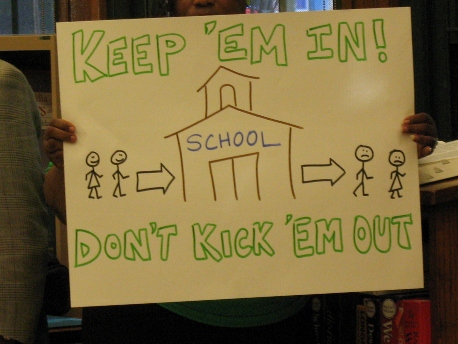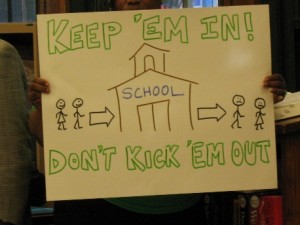
About 50 Latino and African American parent activists from POWER-PAC (Parents Organized to Win, Educate and Renew – Policy Action Council) were joined by Ald. Walter Burnett (27th) at a bilingual rally and press conference Friday at Wells Community Academy High School, 936 N. Ashland Ave.
Parents called on Chicago Public Schools (CPS) to reduce suspensions and expulsions in favor of positive alternatives, such as the parent-run Peace Center, a restorative justice program currently operating at Wells School.
 “At a time when CPS is talking about extending the school day to give students more time, it is sad to see Chicago students losing tens of thousands of days of class time each year to suspensions and expulsions,” said Lynn Morton, POWER-PAC leader and coordinator of the group’s school-based Peace Centers. “We have alternatives that work. We don’t need to send students out onto the streets.”
“At a time when CPS is talking about extending the school day to give students more time, it is sad to see Chicago students losing tens of thousands of days of class time each year to suspensions and expulsions,” said Lynn Morton, POWER-PAC leader and coordinator of the group’s school-based Peace Centers. “We have alternatives that work. We don’t need to send students out onto the streets.”
POWER-PAC’s event coincided with the National Week of Action on School Pushout, a coordinated initiative of the national Dignity in Schools Campaign to call attention to the consequences of punitive, “zero-tolerance” discipline policies that activists say have gone too far.
The group pointed to statistics that nearly 45,000 CPS students, disproportionately students of color, were suspended at least once in the 2009-2010 school year. About 410,000 students in all attend CPS’ more than 500 schools.
“Restorative justice is about repairing the harm, instead of just punishment for punishment’s sake,” said Felipa Mena, Wells parent and co-chair of POWER-PAC. “We work with students to get to the root of the problem. Other schools should do the same.”
A student speaker and Wells Principal Ernesto Matías seconded the parents’ sentiments.
“I think every school should have a peace center,” Wells student Marlene Álvarez said.
 Parents cheered as Burnett announced his support for a Chicago City Council resolution that POWER-PAC and other community organizations are promoting. The resolution, which will be introduced by Ald. Michelle Harris (8th), would call on CPS to reduce suspensions and expulsions by 40 percent through the implementation of restorative justice.
Parents cheered as Burnett announced his support for a Chicago City Council resolution that POWER-PAC and other community organizations are promoting. The resolution, which will be introduced by Ald. Michelle Harris (8th), would call on CPS to reduce suspensions and expulsions by 40 percent through the implementation of restorative justice.
“I don’t think that we need to push young people out of school,” Burnett said. “We need to figure out ways to keep them in school and help them to get an education.”
POWER-PAC launched its Elementary Justice Campaign six years ago and has been successful in getting restorative justice approaches built into the CPS Student Code of Conduct. The group says that in addition to its own programs at three schools, dozens more schools are using alternative discipline approaches, but that too many still resort to punitive practices like out-of-school suspensions and expulsions.
POWER-PAC is a project of COFI (Community Organizing and Family Issues).
Zero Tolerance
Zero Tolerance has not created safer school climates, although out-of-school suspensions does hurt academic progress, contribute to marginalization of students, and is a major factor in students dropping out of school and dropping into the “school-to-prison” pipeline.
Zero-tolerance disproportionate impact students of color: Some 15% of the nation’s black students in grades K-12 are suspended at least once each year, compared with 4.8% of white students. (Source: U.S. Department of Education Office for Civil Rights (OCR)–Civil Rights Data Collection. 2006.)
The routine use of suspensions not just for weapons or drugs, but also for other acts that used to be handled with a visit to the principal’s office or in-school detention, have soared. These lesser violations account for most of the 3.3 million annual suspensions of public school students. Keeping more young people in school means additional time for learning, and when more learning happens, more students graduate. Sidebar: Chicago is the No. 1 on a list of 10 major urban districts when it comes to suspending students.
One study found that students of color are far more likely to be kicked out of school when they possess & use a cellphone than their white peers. Almost 33 percent of first-time black middle school offenders were suspended, compared with 4.5 percent of white students.
The reasons for such wide disparity are unclear. There is ample room for decisions to be influence by cognitive bias and stereotypes held by teachers, principals, coaches, and health officials, even when most Americans truly believe that a person should not be judged by the color of their skin. An Implicit Association Test used to measure unconscious bias needs to be developed for and administered to all educators.
The following policies have unintended and devastating side effects on students of color: War on Drugs; Zero Tolerance and No Child Left Behind. Come let’s us reason together.
“Beware of an idea whose thime has come!” (Emerson)
50-in-10 Policy Institute
Maybe schools should have programs to teach parents how to be parents. I’m sure it would not be surprising to find out that the majority, if not all, of “these” students come from bad homes where parents are either absent most of the time, or are partying in front of their kids, teaching them all the wrong values. It’s ironic that parents are the least accountable in these types of situations, even though they are responsible for the upbringing of their kids. Parents create monsters, and suddenly it the teachers fault for not teaching them right, or the polices fault for not punishing them the right way, or the… these parents are always blame society the problems they create.